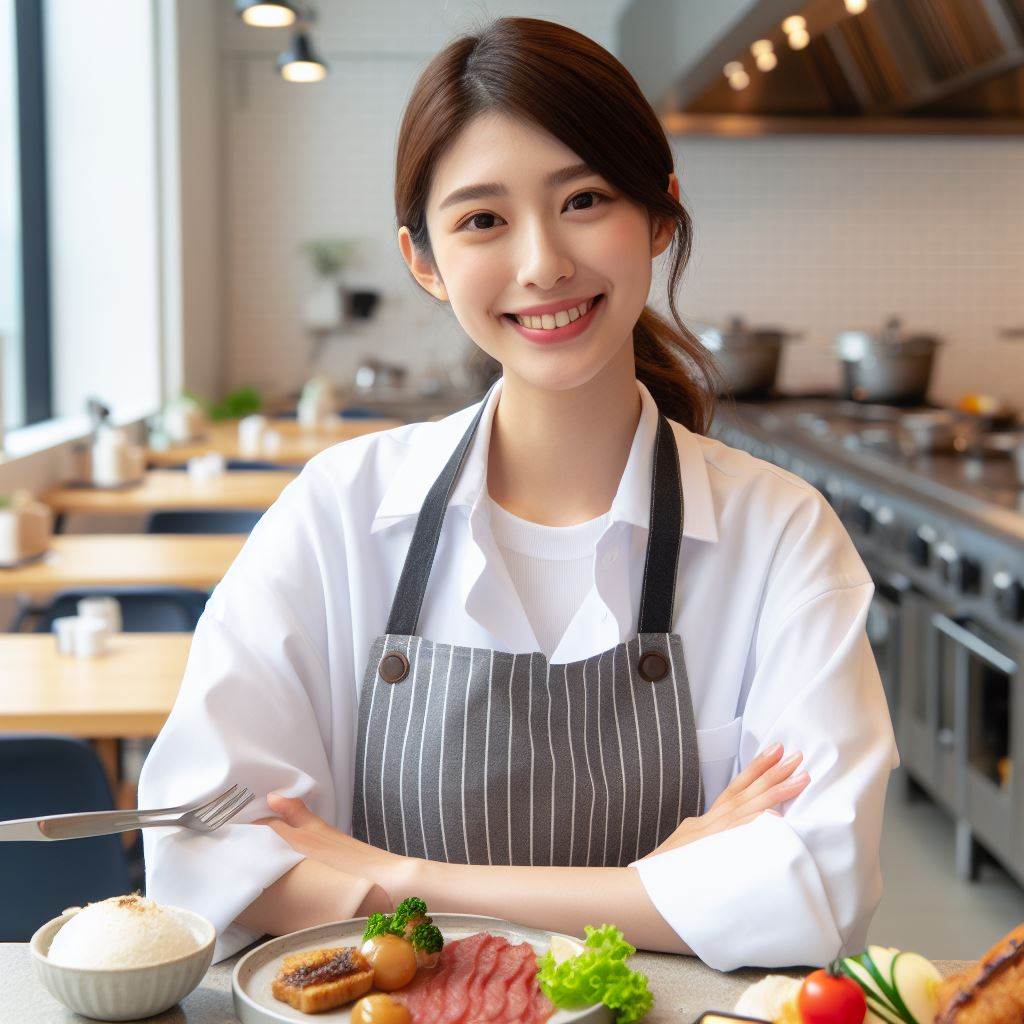Introduction
The art of plating involves much more than simply arranging food on a plate.
It is a creative process that requires careful consideration of colors, textures, and presentation techniques.
Plating is an essential aspect of the culinary world as it not only makes a dish visually appealing but also enhances the overall dining experience.
In this blog post, we will delve deeper into the world of plating, providing insights from some of New Zealand’s finest chefs.
They will share their tips and techniques for creating stunning and appetizing plates.
From the importance of using fresh, seasonal ingredients to the strategic placement of each component, these chefs will unveil the secrets behind their picture-perfect creations.
You will discover the significance of proper portioning and the impact it has on the overall aesthetic of a dish.
The use of tools and techniques, such as piping bags and tweezers, will also be discussed, highlighting their roles in elevating the presentation of a plate.
Furthermore, we will explore the importance of balance and contrast in plating.
The chefs will emphasize how the incorporation of different flavors, textures, and colors can create visually striking and flavor-packed dishes.
We will learn about the importance of garnishes and how they can add that final touch, enhancing the overall appearance of a plate.
Join us on this journey into the art of plating as we unveil the tips and tricks used by top New Zealand chefs to create masterful plates that are as beautiful as they are delicious.
Understanding the Basics of Plating
When it comes to the art of plating, there are several key elements that top NZ chefs keep in mind.
These elements, such as choosing the right plate, utilizing negative space, balancing colors and textures, and selecting appropriate portion sizes, are crucial in creating visually appealing and delicious dishes.
Importance of choosing the right plate
The plate itself is the canvas on which a chef creates their masterpiece.
Personalized Career Consulting
Unlock your potential with expert career advice tailored to your goals. Get personalized guidance and actionable steps toward your dream career in New Zealand.
Get StartedThe choice of plate can greatly affect how the dish is perceived and enjoyed.
For example, a white plate can enhance the colors of the food, while a textured or patterned plate can add visual interest.
Chefs carefully consider the size, shape, and color of the plate to complement the dish they are plating.
Utilizing negative space on the plate for visual appeal
Negative space refers to the empty space on the plate that is not occupied by food.
Chefs use this space strategically to create balance and contrast.
Leaving areas of the plate empty can help highlight the food and make it the focal point.
It also allows for artistic presentation techniques, such as arranging ingredients in a specific pattern or shape.
By thoughtfully utilizing negative space, chefs can enhance the visual appeal of the dish.
Balancing colors, textures, and flavors
One of the most important aspects of plating is achieving balance in colors, textures, and flavors.
Chefs aim to create a visually enticing dish by incorporating a variety of colors that complement each other.
They also consider the textures of the different components, balancing crispy and soft textures, for example.
Additionally, the flavors of the dish should work harmoniously together, ensuring a well-rounded and enjoyable culinary experience.
Choosing appropriate portion sizes
Portion sizes play a crucial role in plating.
Chefs carefully consider the size of each component on the plate to ensure that flavors and textures are properly distributed.
Transform Your Career with a Professional CV and Cover Letter
Stand out to employers with an ATS-optimized resume and tailored cover letter designed to match your dream role. Let us craft your job application materials for success!
Get StartedThe portion sizes should be visually appealing and satisfying to the diner, without overwhelming or leaving them wanting more.
Chefs aim to create a well-balanced dish that not only looks great but also provides a fulfilling and enjoyable eating experience.
Mastering the art of plating requires a deep understanding of these basic principles.
By choosing the right plate, utilizing negative space effectively, balancing colors, textures, and flavors, and selecting appropriate portion sizes, top NZ chefs create visually stunning and delectable dishes that leave a lasting impression on diners.
Read: Emerging Chefs: NZ’s Rising Culinary Stars
Tip 1: Creating Eye-catching Compositions
A well-plated dish not only tantalizes the taste buds but also pleases the eyes.
Top New Zealand chefs have mastered the art of plating, and here are some tips they swear by:
Using the rule of thirds to arrange elements
One of the fundamental principles of design is the rule of thirds.
When plating a dish, imagine the plate divided into nine equal sections using two horizontal and two vertical lines.
Place key elements along these lines or at the intersections to create balance and visual interest.
This technique draws the viewer’s eye to different parts of the plate and creates a harmonious composition.
Incorporating different heights and levels on the plate
Adding height and variation in levels can instantly elevate the visual appeal of a dish.
Consider stacking ingredients or using garnishes, such as edible flowers or microgreens, to add dimension and depth.
This not only makes the plate more visually interesting but also adds texture and complexity to the overall dining experience.
Boost Your Career with a Standout LinkedIn Profile
Attract recruiters and expand your network with a fully optimized LinkedIn profile tailored to highlight your strengths and professional goals. Let your profile open doors to new opportunities!
Get OptimizedPlaying with shapes and angles to enhance visual interest
Don’t limit yourself to arranging ingredients in a symmetrical manner. Instead, experiment with different shapes and angles to create a dynamic composition.
or example, arrange long, thin ingredients diagonally across the plate or use circular elements to create contrast.
These subtle tweaks can make a significant impact on the overall visual appeal.
Remember, each element on the plate should serve a purpose and contribute to the overall composition.
Every choice, from the placement of ingredients to the use of negative space, should be intentional and thoughtfully considered.
By following these tips from top New Zealand chefs, you can take your plating skills to the next level and impress both your guests and yourself.
Remember to embrace creativity and practice to develop your own unique plating style. Bon appétit!
Tip 2: Colors and Contrast
When it comes to the art of plating, colors play a significant role in creating visually appealing dishes.
Great chefs understand that a well-executed color palette can enhance the overall dining experience.
Here are some tips from top NZ chefs on using colors and contrast effectively:
Selecting a color palette that complements the dish
Choosing the right color palette for a dish requires a keen eye and a good understanding of color theory.
The goal is to create harmony and evoke certain emotions through the visual presentation of the food.
Chefs recommend considering the ingredients’ natural colors and selecting complementary hues to create a visually balanced and aesthetically pleasing plate.
Using contrasting colors to make the dish pop
Contrast is an essential element in creating visually striking plates.
The use of contrasting colors creates a sense of visual excitement and makes the dish stand out.
Chefs advise using complementary colors, such as pairing vibrant reds with deep greens or bright oranges with deep purples, to create a visually appealing contrast.
This technique not only adds visual interest but can also enhance the flavor perception of the dish.
Adding garnishes and edible flowers for an extra touch of color
Garnishes and edible flowers are excellent tools for adding an extra touch of color to the plate.
Chefs advise using fresh herbs, microgreens, or edible flowers that complement the dish’s flavors and colors.
These small additions not only enhance the visual appeal but also provide an opportunity to introduce new flavors and textures to the dish.
However, chefs caution against going overboard with garnishes, as simplicity is often key to achieving a refined and elegant plating style.
When incorporating colors and contrast in plating, it’s crucial to consider the dish’s overall composition and create a visual balance.
Overwhelming the dish with too many colors or contrasting elements can result in a chaotic and unappetizing presentation.
Top chefs emphasize the importance of restraint and deliberation in order to create visually stunning plates that highlight the flavors and textures of the food.
In essence, colors and contrast are powerful tools in the art of plating.
Selecting a complementary color palette, using contrasting colors strategically, and adding vibrant garnishes are all effective techniques for creating visually appealing dishes.
However, it is essential to approach plating with balance and restraint to ensure that the final presentation is both visually stunning and enhances the dining experience.
With these tips from top NZ chefs, you can elevate your plating skills and create beautiful, enticing dishes that will impress your guests.
Read: Seafood Specialties: NZ Chefs’ Best Creations
Tip 3: Paying Attention to Texture
Achieving the perfect plating goes beyond just the visual appeal of a dish.
Top New Zealand chefs understand that texture plays a crucial role in elevating the overall dining experience.
In this section, we will explore the importance of incorporating varied textures in a dish and using different cooking techniques to create contrasting textures.
Additionally, we will discover how adding crunchy or crispy elements can surprise and delight the palate.
Incorporating Varied Textures in the Dish
When it comes to plating, texture is just as important as taste and presentation.
A well-balanced dish should offer a mix of textures that complement each other.
When considering a dish, top chefs pay careful attention to the components and ingredients that can bring a range of textures to the plate.
For example, a creamy sauce paired with a tender protein or a soft puree can create a luxurious and velvety mouthfeel.
Adding some steamed vegetables or blanched greens provides a refreshing crispness that contrasts with the smoothness of the other elements.
The juxtaposition of textures not only adds dimension to the dish but also engages the senses, making every bite an exciting experience.
Using Different Cooking Techniques to Create Contrasting Textures
Varying the cooking techniques used in a dish is another technique employed by top chefs to achieve contrasting textures.
By experimenting with different methods such as grilling, roasting, frying, or poaching, chefs can create a diverse range of textures that add interest and complexity to the plate.
For example, a perfectly seared piece of fish with a caramelized crust offers a delightful crispiness on the outside while remaining tender and delicate inside.
Pairing it with a smooth puree or silky sauce adds a velvety consistency, enhancing the overall texture profile of the dish.
By skillfully combining different cooking techniques, chefs can transform a simple dish into a multi-textured masterpiece.
Adding Crunchy or Crispy Elements for a Pleasant Surprise
One way to elevate the dining experience is by incorporating crunchy or crispy elements into a dish.
These unexpected textures provide a pleasant surprise to the palate and create a memorable eating experience.
Top New Zealand chefs often use ingredients like toasted nuts, seeds, or crumbled crackers to achieve this effect.
They may also add a garnish of fried herbs or thinly sliced vegetables that have been quickly cooked until they turn crisp.
These elements not only add a delightful crunch but also offer a visual contrast to the other components on the plate.
By strategically placing these crunchy or crispy elements throughout the dish, chefs ensure that each bite provides a burst of texture and flavor.
This attention to detail keeps the diner engaged and adds an extra layer of complexity to the overall dining experience.
In fact, texture plays a significant role in the art of plating.
The incorporation of varied textures in a dish, achieved through different cooking techniques and the addition of crunchy or crispy elements, elevates the dining experience.
Top New Zealand chefs understand the importance of engaging all the senses and strive to create plates that not only look visually stunning but also offer a symphony of textures that surprise and delight the palate.
Read: Wine & Dine: Chef Pairings in NZ’s Vineyards

Tip 4: Sauces and Drizzles
When it comes to the art of plating, sauces and drizzles play a crucial role in enhancing both the visual appeal and taste of a dish.
Top New Zealand chefs understand the importance of properly saucing the plate to create a stunning presentation.
Properly saucing the plate to add visual appeal
Saucing the plate is not just about randomly splashing sauce around. It requires a careful and strategic approach to ensure harmony and balance.
Each dollop or swipe of sauce should be purposeful and intentional, contributing to the overall aesthetics of the plate.
Using squeeze bottles and brushes for precise drizzling
To achieve precision in saucing, professional chefs often use squeeze bottles and brushes.
These tools provide greater control and allow for intricate designs and patterns.
A simple drizzle from a squeeze bottle or a delicate brush stroke can transform a dish into a work of art.
Balancing flavors and ensuring the sauce complements the dish
However, it is important to remember that sauces and drizzles are not only for visual appeal.
They also play a significant role in enhancing the flavors of the dish.
A well-executed sauce can bring together different elements on the plate, tying them together in a harmonious marriage of taste.
When creating sauces, chefs carefully consider the flavor profile of the dish.
The goal is to create a sauce that complements and elevates the ingredients, rather than overpowering them.
The right sauce can enhance the natural flavors and textures, making each bite a delightful experience.
Besides selecting appropriate flavors, chefs also pay attention to the texture and consistency of the sauce.
A thick, creamy sauce may be perfect for a luscious steak, while a light, tangy drizzle may work wonders on a delicate seafood dish.
The texture should enhance the overall eating experience and provide a satisfying mouthfeel.
Furthermore, chefs understand the importance of balance when it comes to saucing and drizzling.
Too much sauce can overpower the dish, while too little may leave it lacking in flavor
Achieving the right balance requires skill and practice.
One technique often employed by chefs is to place the main protein or focal point of the dish in a pool of sauce.
This ensures that every bite incorporates a perfect balance of flavors.
Additionally, chefs may use multiple sauces or drizzles to add layers of complexity and create a visually stunning plate.
Ultimately, the art of saucing and drizzling is a testament to a chef’s creativity and attention to detail.
It adds depth and dimension to a dish, turning it into a multisensory experience.
So the next time you dine at a top New Zealand restaurant, take a moment to appreciate the carefully crafted sauces and drizzles that elevate the culinary masterpiece in front of you.
Read: Kiwi Culinary Trends: Chef Insights for 2024
Tip 5: Garnishes and Edible Decorations
Garnishes and edible decorations play a crucial role in elevating the visual appeal of a dish.
The right choice of garnishes can enhance the overall presentation and make the dish more enticing to the eyes.
By using edible flowers, microgreens, and herbs creatively, you can add a touch of flair to your culinary creations. Here are some tips on choosing and using garnishes effectively:
Choosing appropriate garnishes based on the dish
Consider the flavor and style of your dish when selecting garnishes.
Look for ingredients that complement the main flavors and textures of the dish.
For example, if you’re serving a seafood dish, garnishing with lemon wedges or slices can add freshness and acidity to balance the richness of the seafood.
Fresh herbs like basil, cilantro, or parsley can be great options for garnishing dishes with a Mediterranean or Asian influence.
Remember to keep the garnishes simple and in harmony with the overall flavor profile of the dish.
Using edible flowers, microgreens, and herbs for added flair
Edible flowers not only add visual appeal but also bring delicate and subtle flavors to the dish.
Choose flowers that are safe to eat, such as pansies, violets, nasturtiums, or marigolds.
Microgreens are young vegetable greens that are packed with flavor and nutrients.
They come in various colors and textures, making them perfect for adding an extra pop of color and freshness to your dishes.
Herbs like chives, dill, or mint can be used as garnishes to add aromatic notes and enhance the overall taste of the dish.
Experiment with different combinations of edible flowers, microgreens, and herbs to create visually stunning and flavorful garnishes.
Placing garnishes strategically to enhance the overall presentation
Remember that garnishes should not overpower the main dish but rather complement its presentation.
Place garnishes strategically, considering the shape and color of the dish.
For example, if you have a round-shaped plate, balance it with a vertical garnish like a sprig of rosemary.
Use contrasting colors to make the garnishes stand out.
For example, if the dish is predominantly white, garnish with vibrant green herbs or colorful edible flowers to create visual interest.
Consider the size and texture of the garnish.
Delicate microgreens and small edible flowers can be scattered or arranged in a cluster, while larger herbs can be used as bold focal points.
In short, garnishes and edible decorations are essential elements in the art of plating.
They provide an opportunity to enhance the visual appeal of your dishes and showcase your creativity.
By carefully choosing appropriate garnishes, using edible flowers and microgreens, and strategically placing them on the plate, you can transform a simple dish into a visually stunning masterpiece.
Remember to experiment, have fun, and let your culinary imagination run wild!
Tip 6: Playing with Temperature
In the culinary world, the art of plating goes beyond just the presentation of food.
It involves the meticulous arrangement of ingredients on a plate to create a visually appealing and aesthetically pleasing dish.
Top New Zealand chefs have mastered this art and generously share their tips and tricks.
In this section, we will explore the sixth tip from these culinary experts: playing with temperature.
Incorporating hot and cold elements in the dish
One of the key aspects of playing with temperature is the combination of hot and cold elements within a single dish.
This creates a delightful contrast that not only enhances the flavors but also adds visual interest.
Picture a succulent grilled steak served alongside a refreshing chilled salad.
The temperature difference adds complexity and excitement to the overall dining experience.
Using chilled plates or warm plates to maintain desired temperature
Another way to play with temperature is by considering the temperature of the plate itself.
Top chefs often use chilled plates or warm plates to help maintain the desired temperature of the dish.
For example, a chilled plate can help keep a delicate seafood appetizer cold and fresh, while a warm plate can keep a hearty main course warm throughout the meal.
The choice of plate temperature is crucial in ensuring that the intended temperature of the dish is preserved until the last bite.
Creating contrast in temperatures for a unique dining experience
One of the reasons top chefs incorporate temperature contrast in their dishes is to create a unique dining experience for their guests.
By carefully selecting ingredients that can be served at different temperatures, chefs can surprise and delight diners with unexpected combinations.
Imagine a dessert that combines a warm, gooey chocolate cake with a chilled scoop of vanilla ice cream.
The hot-cold contrast not only pleases the taste buds but also adds an element of excitement and surprise.
When playing with temperature in plating, chefs must also consider the practicality of maintaining the desired temperature.
It is important to ensure that the hot elements stay hot and the cold elements stay cold, even after plating.
Chefs often use various techniques to achieve this, such as strategic use of heat lamps or preheated plates for hot dishes, and refrigeration or ice baths for cold dishes.
The goal is to deliver a dish that not only looks visually stunning but also tastes exceptional.
In general, playing with temperature is a technique that top New Zealand chefs use to elevate their plating skills.
By incorporating hot and cold elements, using chilled or warm plates, and creating contrast in temperatures, they create dishes that are not only visually appealing but also offer a unique and memorable dining experience.
So, the next time you dine out or prepare a special meal, consider experimenting with temperature to add a new dimension to your culinary creations.+
Tip 7: Practice and Experimentation
The importance of practice in perfecting plating skills
Plating is an art form that requires precision, creativity, and attention to detail.
Just like any other skill, practice is crucial in mastering this craft.
Repetition allows chefs to become more familiar with different plating techniques and develop muscle memory, making the process smoother and more efficient.
Through practice, chefs can experiment with various arrangements, textures, and flavors, refining their abilities to create visually stunning, balanced, and flavorful dishes.
The more chefs practice their plating skills, the more confident and skilled they become in transforming their culinary creations into aesthetically pleasing works of art.
Always seeking inspiration and trying new ideas
Plating is not just about technique; it is also about creativity and innovation.
Chefs must always seek inspiration from various sources to keep their plating styles fresh and exciting.
Trying new ideas allows chefs to push boundaries and challenge traditional plating norms, resulting in unique and captivating presentations.
Exploring different cuisines, cultures, and artistic mediums can provide a wealth of inspiration that can be translated into new and exciting plating concepts.
By staying open-minded and continuously experimenting, chefs can discover innovative ways to present their dishes, creating memorable experiences for their diners.
Learning from top NZ chefs and their plating techniques
New Zealand is home to a vibrant culinary scene, with many top chefs known for their exceptional plating skills.
By studying and learning from these talented professionals, chefs can expand their understanding of plating techniques and gain valuable insights.
Watching how top NZ chefs meticulously arrange ingredients, use different textures, and play with colors can inspire chefs to elevate their own plating styles.
Interacting with renowned chefs and attending workshops or masterclasses can provide unique opportunities to observe and learn from their expertise firsthand.
Through collaboration and sharing ideas, chefs can continue to innovate and evolve, pushing the boundaries of plating and creating extraordinary dining experiences.
In review, practice and experimentation are essential elements in mastering the art of plating.
By dedicating time to honing their skills, seeking inspiration, and learning from experienced chefs, aspiring platers can elevate their craft and create visually stunning and memorable dishes.
Conclusion
A summary of key tips from top NZ chefs for artful plating: attention to detail, balance of colors and textures, and the use of negative space.
Encouragement to explore and develop one’s own plating style, experimenting with different techniques and presentations.
Acknowledgment of the impact a well-plated dish can have on the dining experience, enhancing the visual appeal and creating anticipation.




